Before we begin
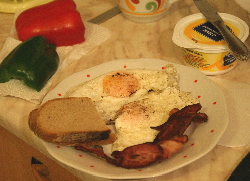
Let’s take a minute to look at where we are going. Picture it with me: a plate, two fine slices of bacon on one side, toast on the other, still warm, the butter melted into it. In between is a pair of fried eggs, steaming, the whites of the eggs firm. Your mouth watering in anticipation, you tear off a chunk from the top slice of toast and poke the corner into the yolk of one of the eggs. The lightly-cooked top of the yolk yields easily and out flows the deep yellow treasure within. Ohhhh, heaven.
Creating that perfect culinary moment is a dance with heat and time, a graceful ballet that is every bit as pleasurable as the final product. There are decisions along the way, opportunities to add the subtle nuances that make those eggs uniquely yours. This guide, then, is a framework in which your improvisation can succeed.
Theory
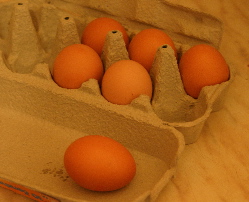
The theory is discussed more in-depth in the original article, but before we go rushing off to the kitchen, let us pause for the tiniest of moments to look at just what an over-easy egg is. It is an egg that has been fried so that the white is cooked but the yolk is still runny. It is the challenge of cooking one part of the egg without cooking the other that makes the over-easy egg the greatest egg-cooking accomplishment. It will take all our skill and timing to defy the laws of thermodynamics so.
Sunny-side up eggs also have the runny yolk, but the top layer of the white is not firm, either. Our goal is to flip the egg just long enough to firm up that top layer of white and then get it off the heat before the yolk cooks. It’s not really that difficult, it’s just that no one does it right, especially in restaurants. (Please feel free to refer the cook at your favorite diner to this page. While the equipment and procedures are different, this is really all about the flip. He’ll thank you later as the humble restaurant becomes internationally famous for the excellence of their over-easy eggs.)
Preparation
Sun Tsu, in The Art of War, says (something like) “A good general wins the battle before it begins.” This applies to cooking as well. Your success depends on what you do before you light the stove.
This morning we will be cooking three items, the three instruments in our little culinary composition. Once the music starts there will be no time scrounge up important tools or ingredients without casting a sour note; anything you can do now, before heat is applied to food and the march of thermodynamics cannot be turned back, will make things easier later. You will need: eggs, bacon, bread, butter, a toaster, a frying pan, a spatula (preferably metal – the thinner the better), paper towels, a plate, a fork, and a table knife. Get them out ahead of time and place them all within easy reach. Make sure you have room to work next to the stove as well.
Lay out your work space. Put the pan on the stove, the spatula and the fork nearby, and put a paper towel on the plate. Put the bread by the toaster. Check the butter to make sure it’s not too firm to spread on the toast easily. Touch each thing once with your hand so your body will remember its place. You will find yourself automatically putting things back in their places later, so you don’t have to expend unnecessary mental energy with the details. You’re an artist, baby! No time to be groping for brushes when the passion strikes!
Note: Years later I’ve learned from watching Worst Cooks in America that the above ritual is called mise en place – everything in its place. Taking sixty thin seconds now to lay everything out makes things so much easier later that you will suddenly feel like a good cook. Because you will be.
Take a deep breath. Relax. This is going to be great!
Ready? The conductor is stepping to the podium. A hush descends over the concert hall. It’s time to fire up the stove.
Bacon
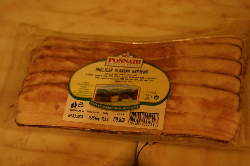
There are many reasons not to eat bacon: Political, religious, economic, environmental, and health issues abound. On the other hand, there’s only one reason to eat it: It’s yummy. Bacon has the side effect of providing grease to lubricate the pan while you cook your eggs as well. When cooking for myself (as is usually the case), two slices of bacon is plenty. Cooking bacon is simple, really; plop a couple strips into the pan and as it heats you will hear the sizzling begin. Keep a close ear on that sound; that’s your thermometer. If things start to sizzle and pop with too much abandon, turn the heat down a bit.
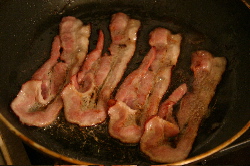
I’m a “busy” cook, so I harass the bacon with my fork as it cooks, pushing it around to make sure it doesn’t get stuck, flipping it more than is strictly necessary, and generally robbing the bacon of any chance to relax as the meat cooks and some of the fat is turned to liquid. How long you cook the bacon is entirely up to you. While I want my bacon to be cooked through I don’t like it to snap when I bend it. If you’re cooking for strangers, always make it crispy. When your bacon is done turn the heat way down on the stove and hoist those puppies out. Put them on the paper towel to absorb some of the grease still bubbling in the strips.
There’s your pan, waiting for the main event…
Toast
But hold on, there, Sparky! That intriguing, inviting frying pan calling your name is trying to lead you astray! What started as a gentle waltz is speeding up now — it is a fugue, and the goal is to have all the lines of the music end at the same time. Once you’ve been around the block a couple of times you’ll know: the toast takes longer to cook than the eggs. There’s nothing worse than scooping the eggs out of the pan and onto the plate, steaming, gleaming, calling to you, and having to wait for the toast. Oh, I’ve been there many times, my friends, and it hurts. Send two slices down into the fiery maw of the toaster and turn your attention back to the frying pan.
The Eggs
You’re moving gracefully now from plate to toaster to pan, and utensils are jumping into your hand before you even think of them. The eggs are there, waiting, but first let’s take a look at that pan. You’ve got some big decisions to make. The bacon has left behind two things; grease and crispy critters. The first decision is an easy one based entirely on taste: Do you scrape out the crispy critters? Personally, I leave them in. They can become a sticking point during the flip, but I like what they add to the egg. The second question is tougher: Do you have too much grease in the pan? If you only cooked a couple of slices of bacon you’re probably OK. If you cooked more it’s time to take some of the grease out of the pan. I generally just soak some of it up with a paper towel. Pouring it down the sink is a bad idea, unless you’re looking for an excuse to have that cute plumber come over.
Remember, that’s hot hot grease there! Be careful!
Naturally, if you are not a bacon-eater, you will have to add butter or oil to the pan and you’re completely out of luck on the crispy critters. Also, without lovely bacon goodness, you’ll probably want to add a sprinkle of salt and maybe a touch of black pepper.
The pan is ready. It’s time to turn the heat back up for a few moments and put in the eggs. Eggs – check. Spatula – check. All right. Crack open that first egg and drop her in!
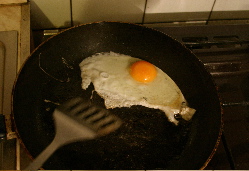
Not so fast there, buckaroo! I saw you reaching for that next egg! This is the first half of the secret to perfect over-easy eggs. Don’t put in the second egg yet! The reason will be obvious when we get to the flip. Instead, it’s time to use your spatula to adjust the sprawl of the first egg. As you look at the egg sitting in the pan, you will see three distinct parts. There is the yolk, the inner white part, and the outer white part. While the first two parts are relatively self-contained, the outer white will run all over the place. The farther it runs, the thinner it gets and the faster it cooks. If you like little crispy-crinkly bits around the edges, then some sprawl is desirable. If your stove is not level (mine isn’t) some of the outer white will make a break for it. Just push it back where it belongs and everything will be all right.
That other egg is calling to you. Your hand is starting to twitch. You can no longer resist the need to start the next egg cooking. Crack it open and drop it in, adjusting sprawl as above.
Pop! goes the toaster. Never taking your eyes off the eggs, pull the toast out and butter it. Dump the bacon off the towel onto the plate, and put the toast next to it.
The Flip
The moment has come to flip the eggs. How do you know when that moment has arrived? It is when the inner white portion is almost completely cooked. Only practice, practice, and more practice will allow you to recognize this moment every time, but here’s the second part of the arcane secret for cooking eggs over easy: Don’t flip the eggs too soon! While the egg is sunny-side up, the yolk is floating on top and the white acts as an insulating layer, protecting the yolk from the heat of the pan. Alas, some of the white is also insulated, and to get that part firmed up we must risk everything and flip the egg over for a few agonizing seconds.
Before we go doing something crazy that could injure our precious yolk, make sure the egg is free and loose. Everything cool? Well then, flip the first egg, and only the first egg. This is why you waited before putting the second egg in. The egg will be flipped for such a short time that you don’t want to get caught fooling around with egg number two while egg number one overcooks. After just a few seconds scoop the first egg out and flip it yolk-side-up onto your plate. Now repeat the process with egg number two.
Turn off the stove, step back, and take a look at the beauty you have wrought.
Some final comments
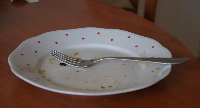 While I have tried to be specific, there are many aspects of timing and temperature that I just cannot be exact about. Everything from how you like your toast to the weight of your frying pan will affect your outcome. Only experimentation will lead to your oval nirvana. If they don’t come out just right the first time, relax. I bet it’s still way better than what you would get at Denny’s. The process is, as I mentioned above, a complex and delicate composition, and like all great works of art, each performance carries with it some risk.
While I have tried to be specific, there are many aspects of timing and temperature that I just cannot be exact about. Everything from how you like your toast to the weight of your frying pan will affect your outcome. Only experimentation will lead to your oval nirvana. If they don’t come out just right the first time, relax. I bet it’s still way better than what you would get at Denny’s. The process is, as I mentioned above, a complex and delicate composition, and like all great works of art, each performance carries with it some risk.
Finally, I did not include the preparation of any beverages in this framework. I know there are those who are as passionate about their coffee as I am about my eggs, and I invite your input.
I hope this little how-to helps you. If we all band together, perhaps one day we can rid the world once and for all of the scourge of too-soon-flipped eggs. And remember as Valentines day hurtles toward us that the best way to start the day is to bring your sweetie breakfast in bed. A beautifully orchestrated, lovingly presented plate full of grub says “I love you” like nothing else. (Don’t forget to clean the kitchen.)

